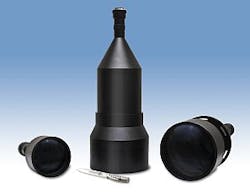Lensation telecentric lenses for use at large working distances
The TD series of telecentric lenses can be used at large working distances of 256, 400 and 470 mm and magnification factors of 0.38, 0.24, and 0.1. They are designed for use with sensors featuring a 16, 12 or 4 Mpixel resolution, in applications such as offline shape measurement of large extruded plastic and metal parts.
Lensation
Karlsruhe, Germany
[email protected]
More Products
-----
PRESS RELEASE
Up to 16 megapixels resolution: Telecentric lenses from Lensation
Karlsruhe – Telecentric lenses from Lensation's TD series can be used at very large working distances. Designed for use with sensors featuring a 16, 12 or 4 megapixel resolution, they are available in three versions with working distances of 256, 400 and 470 mm and magnification factors of 0.38, 0.24 und 0.1. They provide reliably measured data in inspection and measuring tasks with varying distances between the camera and the measured object where conventional lenses would provide different results depending on the distance. A cost-efficient, high-quality alternative to other lenses on the market, TD lenses are well-suited for tasks such as offline shape measurement of large extruded plastic and metal parts.
Conventional lenses act similar to the human eye: approaching objects seem to grow larger. With telecentric lenses however, the object size does not change, allowing them to detect the size of an object even when its distance is not known. This is based on the principle of the telecentric optical path: on the object side and/or on the image side, it is parallel to the optical axis. Object-space telecentric lenses are used to detect objects without any perspective distortion. This requires a front lens that is at least as big as the object to be measured. The magnification does not change when the object is moved on the optical axis. Therefore, the resulting image will always be the same size regardless of the distance to the object. Measurement lenses use this characteristic to allow for a certain tolerance regarding the distance and position of the parts to be measured. The TD series provides minimal distortion along with extremely high resolution, allowing users to greatly improve their measuring accuracy. At a 16 megapixel resolution, the maximum field of vision for a 36 x 24 mm sensor is currently 150 x 100 mm.
Company Background
Founded in 2006, Lensation GmbH specializes in the manufacturing, distribution and design of industrial lenses. The Karlsruhe-based company provides a wide range of lenses, focusing on particularly demanding applications. Lensation procures image processing components with specifications according to customer requests, drawing on close contacts with suppliers from Asia. If a desired product is not available, Lensation also provides development services including exclusive custom-tailored OEM models and contract manufacturing according to customer designs. The service range also includes free-of-charge consultation on the topics of lenses, lighting, optical components and intelligent cameras.
-----
Follow us on Twitter
Follow OptoIQ on your iPhone; download the free app here.
Subscribe now to Laser Focus World magazine; it's free!
